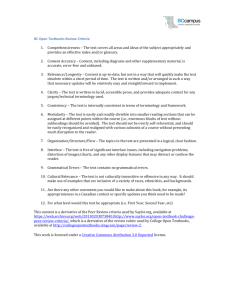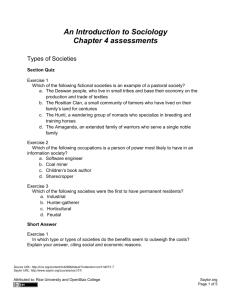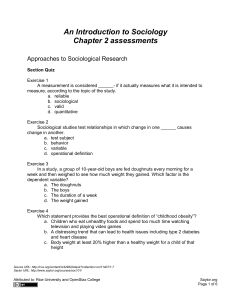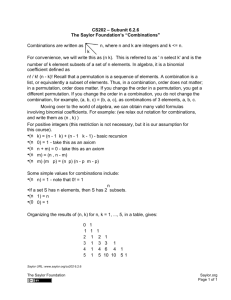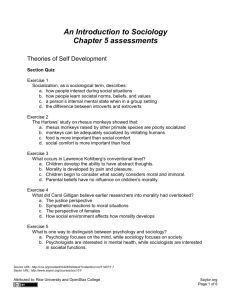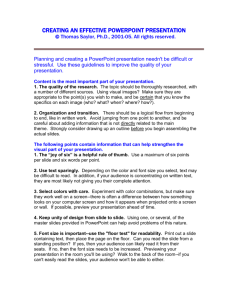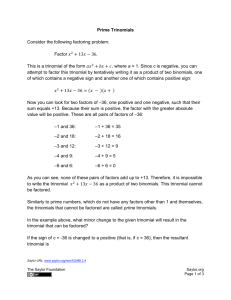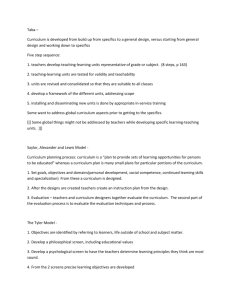An Introduction to Sociology Chapter 3 assessments
advertisement
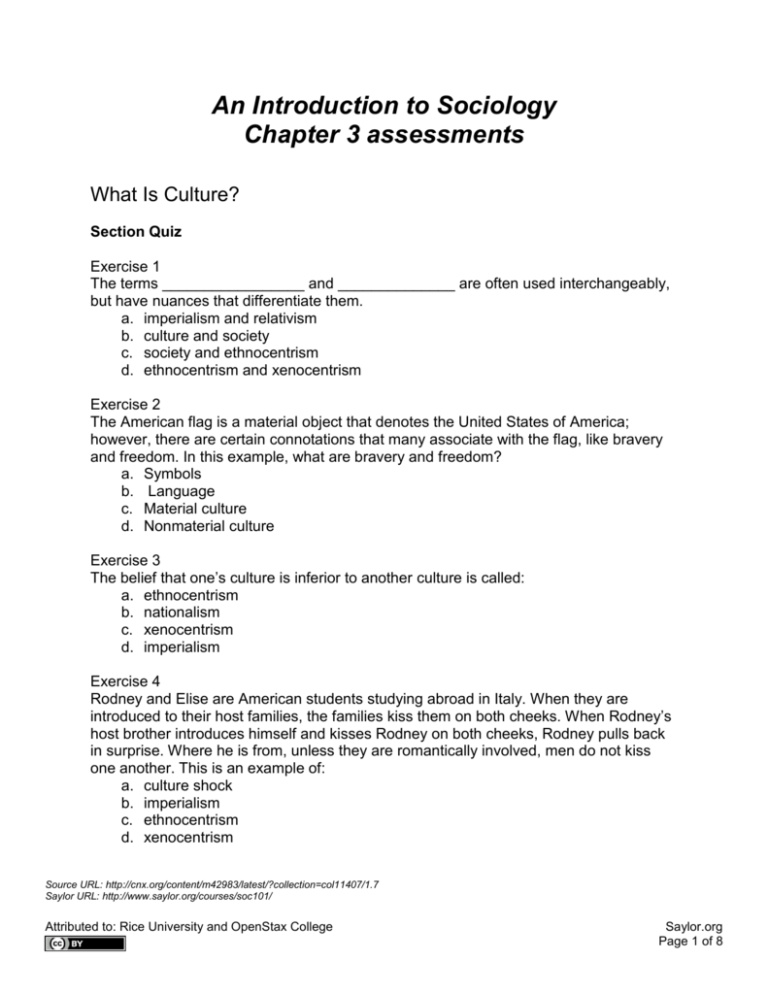
An Introduction to Sociology Chapter 3 assessments What Is Culture? Section Quiz Exercise 1 The terms _________________ and ______________ are often used interchangeably, but have nuances that differentiate them. a. imperialism and relativism b. culture and society c. society and ethnocentrism d. ethnocentrism and xenocentrism Exercise 2 The American flag is a material object that denotes the United States of America; however, there are certain connotations that many associate with the flag, like bravery and freedom. In this example, what are bravery and freedom? a. Symbols b. Language c. Material culture d. Nonmaterial culture Exercise 3 The belief that one’s culture is inferior to another culture is called: a. ethnocentrism b. nationalism c. xenocentrism d. imperialism Exercise 4 Rodney and Elise are American students studying abroad in Italy. When they are introduced to their host families, the families kiss them on both cheeks. When Rodney’s host brother introduces himself and kisses Rodney on both cheeks, Rodney pulls back in surprise. Where he is from, unless they are romantically involved, men do not kiss one another. This is an example of: a. culture shock b. imperialism c. ethnocentrism d. xenocentrism Source URL: http://cnx.org/content/m42983/latest/?collection=col11407/1.7 Saylor URL: http://www.saylor.org/courses/soc101/ Attributed to: Rice University and OpenStax College Saylor.org Page 1 of 8 Exercise 5 Most cultures have been found to identify laughter as a sign of humor, joy, or pleasure. Likewise, most cultures recognize music in some form. Music and laughter are examples of: a. relativism b. ethnocentrism c. xenocentrism d. universalism Short Answer Exercise 1 Examine the difference between material and nonmaterial culture in your world. Identify ten objects that are part of your regular cultural experience. For each, then identify what aspects of nonmaterial culture (values and beliefs) that these objects represent. What has this exercise revealed to you about your culture? Exercise 2 Do you feel that feelings of ethnocentricity or xenocentricity are more prevalent in U.S. culture? Why do you believe this? What issues or events might inform this? Elements of Language Section Quiz Exercise 1 A nation’s flag is: a. A symbol b. A value c. A culture d. A folkway Exercise 2 The existence of social norms, both formal and informal, is one of the main things that inform ___________, otherwise known as a way to encourage social conformity. a. values b. sanctions c. social control d. mores Source URL: http://cnx.org/content/m42983/latest/?collection=col11407/1.7 Saylor URL: http://www.saylor.org/courses/soc101/ Attributed to: Rice University and OpenStax College Saylor.org Page 2 of 8 Exercise 3 The biggest difference between mores and folkways is that a. mores are primarily linked to morality, whereas folkways are primarily linked to being commonplace within a culture b. mores are absolute, whereas folkways are temporary c. mores refer to material culture, whereas folkways refer to nonmaterial culture d. mores refer to nonmaterial culture, whereas folkways refer to material culture Exercise 4 The notion that people cannot feel or experience something that they do not have a word for can be explained by: a. linguistics b. Sapir-Whorf c. Ethnographic imagery d. bilingualism Exercise 5 Cultural sanctions can also be viewed as ways that society: a. Establishes leaders b. Determines language c. Regulates behavior d. Determines laws Short Answer Exercise 1 What do you think of the Sapir-Whorf hypothesis? Do you agree or disagree with it? Cite examples or research to support your point of view. Exercise 2 How do you think your culture would exist if there were no such thing as a social “norm”? Do you think chaos would ensue or relative peace could be kept? Explain. Source URL: http://cnx.org/content/m42983/latest/?collection=col11407/1.7 Saylor URL: http://www.saylor.org/courses/soc101/ Attributed to: Rice University and OpenStax College Saylor.org Page 3 of 8 Pop Culture, Subculture, and Cultural Change Section Quiz Exercise 1 An example of high culture is ___________, whereas an example of popular culture would be ____________. a. Dostoevsky style in film; “American Idol” winners b. medical marijuana; film noir c. country music; pop music d. political theory; sociological theory Exercise 2 The Ku Klux Klan is an example of what part of culture? a. Counterculture b. Subculture c. Multiculturalism d. Afrocentricity Exercise 3 Modern-day hipsters are an example of: a. ethnocentricity b. counterculture c. subculture d. high culture Exercise 4 Your 83-year-old grandmother has been using a computer for some time now. As a way to keep in touch, you frequently send e-mails of a few lines to let her know about your day. She calls after every e-mail to respond point by point, but she has never emailed a response back. This can be viewed as an example of: a. cultural lag b. innovation c. ethnocentricity d. xenophobia Exercise 5 Some jobs today advertise in multinational markets and permit telecommuting in lieu of working from a primary location. This broadening of the job market and the way that jobs are performed can be attributed to: a. cultural lag b. innovation Source URL: http://cnx.org/content/m42983/latest/?collection=col11407/1.7 Saylor URL: http://www.saylor.org/courses/soc101/ Attributed to: Rice University and OpenStax College Saylor.org Page 4 of 8 c. discovery d. globalization Exercise 6 The major difference between invention and discovery is: a. Invention is based on technology, whereas discovery is usually based on culture b. Discovery involves finding something that already exists, but invention puts things together in a new way c. Invention refers to material culture, whereas discovery can be material or theoretic, like laws of physics d. Invention is typically used to refer to international objects, whereas discovery refers to that which is local to one’s culture Exercise 7 That McDonald’s is found in almost every country around the world is an example of: a. globalization b. diffusion c. culture lag d. xenocentrism Short Answer Exercise 1 Identify several examples of popular culture and describe how they inform larger culture. How prevalent is the effect of these examples in your everyday life? Exercise 2 Consider some of the specific issues or concerns of your generation. Are any ideas countercultural? What subcultures have emerged from your generation? How have the issues of your generation expressed themselves culturally? How has your generation made its mark on society’s collective culture? Exercise 3 What are some examples of cultural lag that are present in your life? Do you think technology affects culture positively or negatively? Explain. Source URL: http://cnx.org/content/m42983/latest/?collection=col11407/1.7 Saylor URL: http://www.saylor.org/courses/soc101/ Attributed to: Rice University and OpenStax College Saylor.org Page 5 of 8 Theoretical Perspectives on Culture Section Quiz Exercise 1 A sociologist conducts research into the ways that Hispanic American students are historically underprivileged in the American education system. What theoretical approach is the sociologist using? a. Symbolic interactionism b. Functionalism c. Conflict theory d. Ethnocentrism Exercise 2 The Occupy Wall Street movement of 2011 grew to be an international movement. Supporters believe that the economic disparity between the highest economic class and the mid to lower economic classes is growing at an exponentially alarming rate. A sociologist who studies that movement by examining the interactions between members at Occupy camps would most likely use what theoretical approach? a. Symbolic interactionism b. Functionalism c. Conflict theory d. Ethnocentrism Exercise 3 What theoretical perspective views society as having a system of interdependent inherently connected parts? a. Sociobiology b. Functionalism c. Conflict theory d. Ethnocentrism Exercise 4 The “American Dream” – the notion that anybody can be successful and rich if they work hard enough – is most commonly associated with which sociological theory? a. Sociobiology b. Functionalism c. Conflict theory d. Ethnocentrism Source URL: http://cnx.org/content/m42983/latest/?collection=col11407/1.7 Saylor URL: http://www.saylor.org/courses/soc101/ Attributed to: Rice University and OpenStax College Saylor.org Page 6 of 8 Short Answer Exercise 1 Consider a current social trend that you have witnessed, perhaps situated around family, education, transportation, or finances. For example, many veterans of the Armed Forces, after completing tours of duty in the Middle East, are returning to college rather than entering jobs as veterans as previous generations did. Choose a sociological approach – functionalism, conflict theory, or symbolic interactionism – to describe, explain, and analyze the social issue you choose. Afterwards, determine why you chose the approach you did. Does it suit your own way of thinking? Or did it offer the best method to illuminate the social issue? Source URL: http://cnx.org/content/m42983/latest/?collection=col11407/1.7 Saylor URL: http://www.saylor.org/courses/soc101/ Attributed to: Rice University and OpenStax College Saylor.org Page 7 of 8 Answers Answers to “What Is Culture?” Section Quiz 1.B, 2.D, 3.C, 4.A, 5.D. Answers to “Elements of Language” Section Quiz 1.A, 2.C, 3.A, 4.B, 5.C. Answers to “Pop Culture, Subculture, and Cultural Change” Section Quiz 1.A, 2.A, 3.C, 4.A, 5.D, 6.B, 7.B. Answers to “Theoretical Perspectives on Culture” Section Quiz 1.C, 2.A, 3.B, 4.C, Source URL: http://cnx.org/content/m42983/latest/?collection=col11407/1.7 Saylor URL: http://www.saylor.org/courses/soc101/ Attributed to: Rice University and OpenStax College Saylor.org Page 8 of 8
